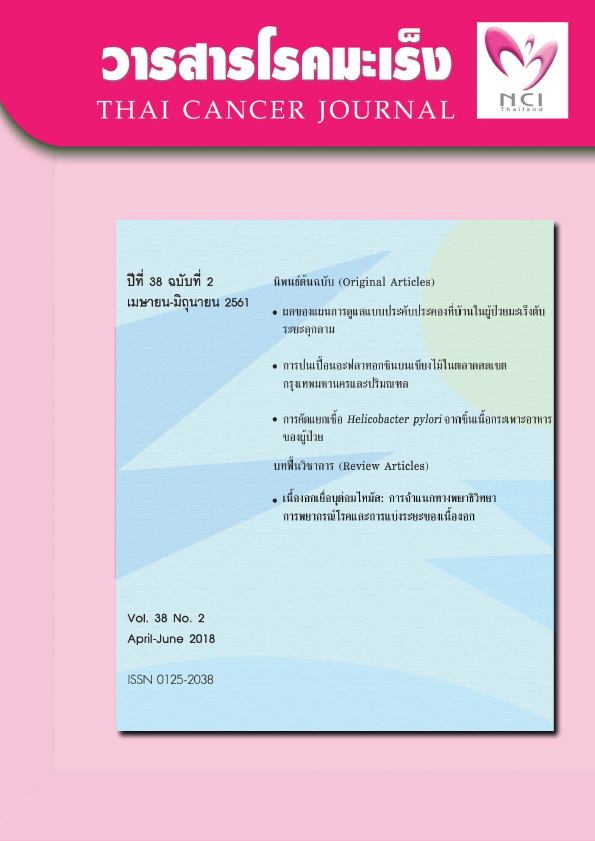การคัดแยกเชื้อ Helicobacter pylori จากชิ้นเนื้อกระเพาะอาหารของผู้ป่วย
คำสำคัญ:
Helicobacter pylori, แผลในกระเพาะอาหาร, การเพาะเลี้ยงเชื้อแบคทีเรีย, สิ่งส่งตรวจชิ้นเนื้อบทคัดย่อ
เชื้อแบคทีเรีย Helicobacter pylori เป็นเชื้อที่พบได้ในกระเพาะอาหารของประชากรทั่วโลกมากถึงร้อยละ 50 โดยร้อยละ 80-95 ของผู้ป่วยที่มีแผลในกระเพาะอาหารหรือลำไส้จะมีการติดเชื้อนี้ และยังพบว่ามีความสัมพันธ์กับการเกิดมะเร็งในกระเพาะอาหารด้วย ซึ่ง International Agency for Research on Cancer ได้จัดให้เชื้อนี้เป็นสารก่อมะเร็งในมนุษย์ การศึกษานี้มีวัตถุประสงค์เพื่อเพาะเลี้ยงและจำแนกเชื้อ H. pylori ในห้องปฏิบัติการจากสิ่งส่งตรวจชิ้นเนื้อกระเพาะอาหารของผู้ป่วยที่เข้ารับการรักษาในสถาบันมะเร็งแห่งชาติ ในช่วงเดือน มีนาคม พ.ศ. 2560 ถึงเดือน มกราคม พ.ศ. 2561 จำนวน 205 ราย โดยทำการทดสอบด้วยวิธี rapid urease test เพื่อตรวจหาเชื้อ ผลการศึกษาพบว่าให้ผลบวกในการทดสอบ คือ พบเชื้อ H. pylori ในสิ่งส่งตรวจ จำนวน 83 ราย เมื่อนำตัวอย่างชิ้นเนื้อมาเพาะเลี้ยงในห้องปฏิบัติการบนอาหารเลี้ยงเชื้อชนิดพิเศษ สามารถเพาะเลี้ยงเชื้อจนสังเกตเห็นการเจริญของโคโลนีได้ทั้งหมด 70 ไอโซเลท เมื่อทดสอบเชื้อที่เพาะเลี้ยงได้ตามคุณสมบัติของเชื้อ H. pylori พบว่าทั้ง 70 ไอโซเลท มีการติดสีของแบคทีเรียแกรมลบ และให้ผลบวกต่อการทดสอบการผลิตเอนไซม์ oxidase เอนไซม์ catalase และเอนไซม์ urease แสดงให้เห็นว่าเชื้อทั้ง 70 ไอโซเลทที่เพาะเลี้ยงได้เป็นเชื้อ H. pylori เนื่องจากเชื้อนี้ตายง่าย ดังนั้นจึงจำเป็นต้องทำการเพาะเลี้ยงอย่างรวดเร็ว โดยทั่วไปไม่เกิน 2 ชั่วโมง การเพาะเลี้ยงเชื้อมีความจำเพาะ 100 เปอร์เซ็นต์ แต่ความไวค่อนข้างต่ำ โดยขึ้นอยู่กับระยะเวลาในการนำส่งตัวอย่าง สภาวะในการเพาะเลี้ยงเชื้อ การปนเปื้อนด้วยเชื้ออื่น ตลอดจนประสบการณ์ของผู้ทำการแยกเชื้อ อย่างไรก็ตามวิธีการนี้เป็นวิธีเดียวที่ทำให้ได้เชื้อบริสุทธิ์ที่สามารถนำไปทดสอบความไวต่อยาปฏิชีวนะและสารออกฤทธิ์ทางชีวภาพ เพื่อเลือกใช้ยาปฏิชีวนะและสารออกฤทธิ์ทางชีวภาพที่เหมาะสมในการรักษาเพื่อช่วยลดปัญหาการดื้อยาของเชื้อ และศึกษาต่อยอดถึงความเป็นไปได้ในการพัฒนาสารประกอบในสมุนไพรเพื่อนำมาใช้ในการรักษาการติดเชื้อ H. pylori
เอกสารอ้างอิง
Warren JR, Marshall BJ. Unidentified curved bacilli on gastric epithelium in active chronic gastritis. Lancet 1983;1:1273-5.
Owen RJ. Helicobacter-species classification and identification. Br Med Bull 1998;54:17-30.
Costa AC, Figueiredo C, Touati E. Pathogenesis of Helicobacter pylori infection. Helicobacter 2009;14:15-20.
Johannes GK, Arnoud HMV, Ernst JK. Pathogenesis of Helicobacter pylori Infection. Clin Microbiol Rev 2006;19:449-90.
Ford AC, Forman D, Hunt RH, Yuan Y, Moayyedi P. Helicobacter pylori eradication therapy to prevent gastric cancer in healthy asymptomatic infected individuals: systematic review and meta-analysis of randomised controlled trials. BMJ 2014;348:g3174.
Fuccio L, Zagari RM, Eusebi LH, Laterza L, Cennamo V, Ceroni L, et al. Meta-analysis: can Helicobacter pylori eradication treatment reduce the risk for gastric cancer? Ann Intern Med 2009;151:121-8.
WHO publishes list of bacteria for which new antibiotics are urgently needed. Available at: http://www.who.int/en/news-room/detail/27-02-2017-whopublishes-list-of-bacteria-for-which-new-antibioticsare-urgently-needed. Accessed March 31, 2018.
Hazell SL, Lee A, Brady L, Hennessy W. Campylobacter pyloridis and gastritis: association with intercellular spaces and adaptation to an environment of mucus as important factors in colonization of the gastric epithelium. J Infect Dis 1986;153:658-63.
Di Bonaventura G, Neri M, Angelucci D, Rosini S, Piccolomini M, Piccolomini R. Detection of Helicobacter pylori by PCR on gastric biopsy specimens taken for CP test: comparison with histopathological analysis. Int J Immunopathol Pharmacol 2004;17:77-82.
Bermejo F, Boixeda D, Gisbert JP, Defarges V, Sanz JM, Redondo C, et al. Rapid urease test utility for Helicobacter pylori infection diagnosis in gastric ulcer disease. Hepatogastroenterol 2002;49:572-5.
Monteiro L, de Mascarel A, Sarrasqueta AM, Bergey B, Barberis C, Talby P, et al. Diagnosis of Helicobacter pylori infection: noninvasive methods compared to invasive methods and evaluation of two new tests. Am J Gastroenterol 2001;96:353-8.
Tseng CA, Wang WM, Wu DC. Comparison of the clinical feasibility of three rapid urease tests in the diagnosis of Helicobacter pylori infection. Dig Dis Sci 2005;50:449-52.
Zheng PY, Jones NL. Helicobacter pylori strains expressing the vacuolating cytotoxin interrupt phagosome maturation in macrophages by recruiting and retaining TACO (coronin 1) protein. J Cell Microbiol 2003;5:25-40.
Nilius M, Strohle A, Bode G, Malfertheiner P. Coccoid like forms (CLF) of Helicobacter pylori. Enzyme activity and antigenicity. Zentralbl Bakteriol 1993;280:259-72.
ดาวน์โหลด
เผยแพร่แล้ว
ฉบับ
ประเภทบทความ
สัญญาอนุญาต
บทความทีตีพิมพ์ในวารสารโรคมะเร็งนี้ถือว่าเป็นลิขสิทธิ์ของมูลนิธิสถาบันมะเร็งแห่งชาติ และผลงานวิชาการหรือวิจัยของคณะผู้เขียน ไม่ใช่ความคิดเห็นของบรรณาธิการหรือผู้จัดทํา







